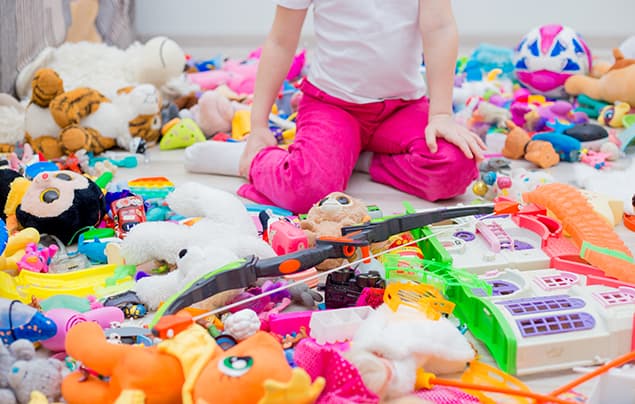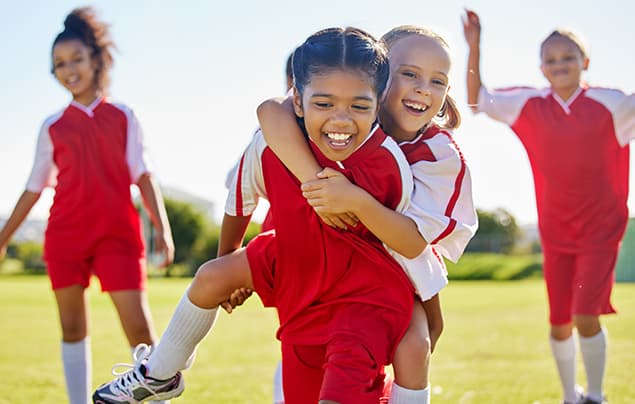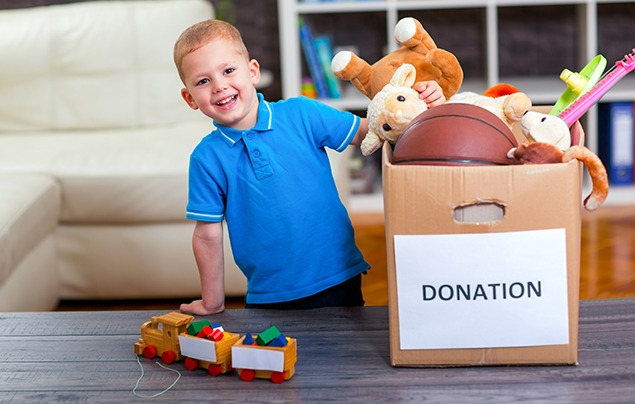Why too much stuff can make kids unhappy
Getting new things can make children feel better – but not for very long. We spoke to the experts to find out more…
It’s no secret that kids love getting new things. But how much stuff is too much stuff? And how do you teach children not to be materialistic, when all they want is the latest toy? If you’ve pondered these questions, you’re not alone. But it turns out that grabbing extra toys and games isn’t just unsustainable – it also doesn’t make kids happy.
“Buying a ton of stuff will only lead to wanting more stuff,” says Choncé Maddox, a personal finance writer and blogger. “It won’t improve your mood long-term or stop you from being bored on the weekends. I wanted to teach this to my son early so he wouldn’t grow up thinking he could buy his way to happiness.” That’s why Maddox started emphasising doing more instead of buying more.
Research suggests that an emphasis on money and material goods during childhood can shape our materialistic values as adults. And though kids need to understand where money comes from and how you earn it, the belief that acquiring more stuff is the key to happiness can be harmful to kids’ development.
“We gravitate to material things because it gives us this boost of happiness,” says Lan Nguyen Chaplin, an associate professor of marketing at the University of Illnois at Chicago. “But we’re caught in this cycle of thinking, ‘If I could just have that toy or shirt, I’d be happier.’”
If a big holiday, flash sale or birthday is coming up soon, this might be a good opportunity to start a conversation with kids about financial values. Here’s how materialism can negatively impact kids, and how parents can teach them better ways to spend.
Materialism and happiness
Youth materialism is strongly associated with low self-esteem, as well as depression, anxiety, decreased motivation, and selfish behaviours. Similarly, materialistic adults tend to be more insecure, less generous, and report lower subjective well-being.
Researchers suggest that this relationship is circular. In other words, feelings of low self-esteem may fuel the desire for material goods that we think will make us happy and symbolise success. But when those goods fail to live up to our expectations, we feel even more dissatisfied, and the pattern of wanting and buying continues.
And initially, it does give you a jolt of joy – until you want the next thing.
In fact, neuroimaging research suggests that shopping can activate our brains’ reward systems and release the feel-good chemical dopamine – but these effects are only temporary. Dopamine is also associated with learning; when something makes us feel good, we’re more likely to repeat the behaviour.
Young people’s developing brains may be more sensitive to these rewards. For example, the nucleus accumbens, known as the brain’s pleasure centre, shows peak activity during adolescence.
How do I teach my child not to be materialistic?
The good news? Parents can counteract some of the materialistic messaging that children receive from peers and marketers. “The secret here lies in spending time with your kids, communicating with them, and fostering a positive sense of self,” Chaplin says.
Avoid using material goods as punishment and reward
Parents can then unwittingly reinforce materialistic messages through something called material parenting – using material goods as a reward for good behaviour and taking them away as a punishment for bad behaviour. This is a common strategy, Chaplin explains. “But in the long run, there’s this focus on material things, and kids grow up to place a greater emphasis on material things as a sign of success and achievement.”
In one study, Chaplin and her colleagues asked adults to recall the degree to which their parents used material goods as rewards or punishment for different behaviours. The participants whose parents relied on this strategy were more likely to judge other people’s success based on the products they have and how much they own.
Talking about advertising
A study by the American Psychological Association found that each year the average child watches more than 40,000 commercials, which often suggest that possessions are directly related to happiness, beauty and success. That may lead to materialistic behaviour being used as a coping mechanism when children don’t live up to advertising ideals.
“Kids don’t even realise what an advertisement is when they’re young – they just see something and they think it’s great,” says Marsha Richins, professor of marketing at the University of Missouri.
Studies have found that forewarning kids about manipulative advertising content can increase their scepticism and reduce their desire for the product. Chaplin says that parents can help them by fact-checking claims and showing them how to think critically about products. For example, if you’re watching a programme together and see an ad for a new phone, it’s the perfect opportunity to say: I wouldn’t buy that phone because I have one that works perfectly well.
Focus on building self-esteem
Instead of focusing on material goods as markers of success, help kids focus on building what Richins calls “intangible resources.” Encourage them to develop friendships and pursue interests that boost their self-esteem without relying on material goods – this shows them that success and achievement don’t necessarily come from buying things.
Materialism is highly correlated with low self-esteem, Chaplin adds. A great way to foster self-esteem is by spending quality time with kids and participating in activities they love. “They’re not going to feel like they need to attach themselves to fleeting objects for a self-esteem boost if they already have high self-esteem.”
Finding better ways to be happy
In general, income isn’t a strong predictor of happiness – but we know from studies in adults that we can spend our extra cash in ways that are more likely to make us happy. So, while kids probably don’t have their own source of income yet, parents can start building these habits now.
Talk to kids about wants vs. needs
Help children understand the value of products, and by extension, how to prioritise spending, Chaplin says. For instance, when a child asks for something, she recommends opening up a conversation about wants and needs: why what they want is unique, how much it costs, and how much of their own money they would need to save to get it. “You’d be surprised how carefully they think about needs and wants when it’s their money,” she says. Kids usually end up seeing more value in saving up for something they really want.
Practise gratitude and giving
Higher levels of gratitude are associated with lower levels of materialism. Researchers suggest this is because gratitude boosts feelings of security, well-being, and generosity, which in turn reduces the emphasis on material goods such as a means of comfort and happiness. In addition to decreasing materialism, gratitude is related to better school performance, lower levels of depression, and stronger social connection.
In one study, Chaplin and her colleagues asked adolescents to write down who and what they were thankful for in a gratitude journal every day. “After about two weeks, they felt like they needed fewer things in their lives,” she says. “And not only that but they felt like they needed to share what they have with others.”
Parents can build gratitude into their family lifestyle by doing things like donating toys kids don’t play with any more. “Children see they have all these excess material goods, and they can share it with people who don’t have enough.”
Invest in experiences – and help kids remember them
Research in adults consistently shows that experiential purchases lead to longer-lasting happiness because people tend to connect over their shared experiences – not their material possessions. That said, very young children typically get more happiness from material things. So, when do kids make the switch? It has to do with brain development.
“I often hear parents complaining about how they shouldn’t have taken their kids on their foreign holiday, because the kids didn’t appreciate it,” Chaplin says. “But the child’s memory skills are just inefficient at a certain age.” Unlike tangible objects, experiences tend to be fleeting and abstract – and little kids simply don’t remember them very well.
As children get older, their memory and recall get better, and they’re able to handle abstract information. That’s when they learn to appreciate experiences better. “They understand that people don’t really like to have conversations about your newest sneakers, but they want to hear about what you did this weekend,” Chaplin explains.
Parents can help younger kids start learning to appreciate experiences by helping them remember. Souvenirs or gifts are concrete objects that can remind them of a family holiday, but you can also create memories for free, Chaplin says. She recommends taking photos and videos of birthday parties, holidays and family time so that you can look back at them together. Because when children start to remember pleasant experiences, they’re more likely to make future choices that increase happiness.
















LEAVE A COMMENT
THANK YOU
Your comment will be checked and approved shortly.
WELL DONE,
YOUR COMMENT
HAS BEEN ADDED!
COMMENTS
CUSTOMIZE YOUR AVATAR